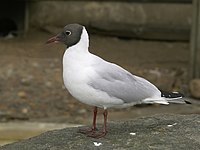
Photo from wikipedia
Roughly 90% of socially monogamous bird species exhibit some degree of extra-pair paternity (EPP), although the extent and the underlying mechanisms vary among species. We analyzed spatial and demographic patterns… Click to show full abstract
Roughly 90% of socially monogamous bird species exhibit some degree of extra-pair paternity (EPP), although the extent and the underlying mechanisms vary among species. We analyzed spatial and demographic patterns of EPP over a 6 year period (2005–2010) as part of a long-term population study of Canada Warblers (Cardellina canadensis (L., 1766)). We identified 12 microsatellite loci used to assess paternity for 185 nestlings from 61 nests. Extra-pair young (EPY) accounted for 41.6% of all nestlings and 57.4% of nests contained at least one EPY. Fewer than half of EPY were sired by males who shared territorial boundaries, and some males sired young in nests 1 km from their territory. The age of social males did not differ from males who cuckolded them. The majority (83%) of EPY were sired by males in older age classes (2+ years old), while <17% were sired by 1 year olds. Of the young sired by older males, 58.5% were sired by males 3–7 years old. Males that sired more EPY sired fewer within-pair young (WPY)...
Journal Title: Canadian Journal of Zoology
Year Published: 2018
Link to full text (if available)
Share on Social Media: Sign Up to like & get
recommendations!